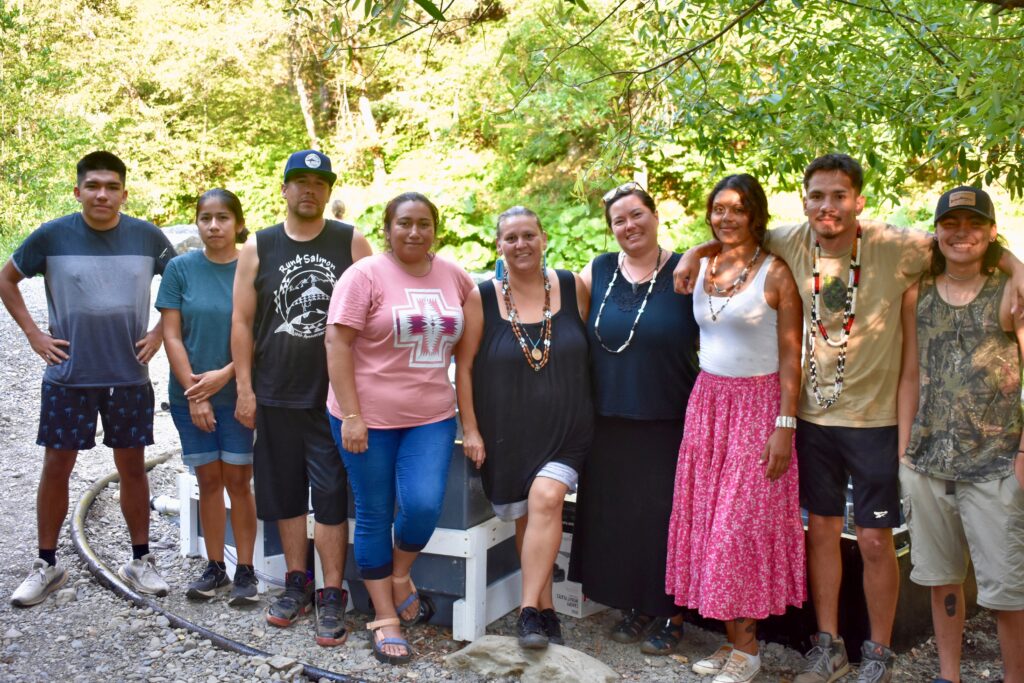This is the fourth year the Winnemem Wintu has co-led the reintroduction of endangered salmon into the river, and they continue to advocate for the creation of a fish passage around Shasta to restore wild salmon runs.
July 25th, 2025, Mount Shasta, California

The Winnemem Wintu Tribe, along with partners NOAA and CDFW, welcomes 80,000 salmon eggs to the Winnemem Waywaket (McCloud River) this summer as part of a groundbreaking mission to reintroduce salmon to the watershed. This is the fourth year of the project. The first batch of eggs was delivered on July 12th, with the remainder coming on July 26th, August 16th, and August 23rd, where the Tribe and partners will greet them with ceremony and prayer.
The eggs, which originate from the Livingston Stone National Fish Hatchery, will be raised in a “Nur Nature Base,” a remote egg incubation system located on the McCloud River that provides a more wild-like rearing setting than conventional hatchery operations. The alevins and fry will have a chance to imprint to the natural rocks and plants of the river, practice swimming in a variety of currents and temperatures, and choose when to leave into the river, where they will either stay in the upper tributaries of the McCloud to feed and grow, or start making their journey downstream toward the ocean. Traps will be placed in the lower McCloud River to catch salmon and move them around Shasta and Keswick Dams to be released into the Sacramento River, near Redding.

In 2023, the Winnemem Wintu Tribe signed historic agreements as equal partners with CDFW and NOAA to restore salmon to the McCloud River. The Winnemem Wintu are the Indigenous people of the McCloud River and have a spiritual, cultural and subsistence relationship with the salmon that spans thousands of years of living together in the watershed. Salmon have been blocked from returning to the river since federal agencies built the Shasta Dam and decided against creating fish passage around the 602 foot structure. The rearing of winter-run hatchery origin salmon is only the first step in the larger goals of the Tribe: 1) to bring back the descendants of the original salmon from the McCloud, who were exported to New Zealand between 1873-1907 and must be rematriated back home, and 2) to build a passage around Shasta and Keswick Dams so the salmon can complete their life cycle from mountain to ocean and back without any human interference. The Tribe aims to restore the genetic descendants of the original salmon that are currently in New Zealand, as they have maintained wild traits such as the ability to swim up mountainous rivers.
The Tribe and partners have recently spotted adult salmon in the McCloud River who were likely reared since the project began in 2022. The Winnemem Wintu Tribe’s Indigenous Traditional Ecological Knowledge (ITEK) indicates that when given the opportunity to be wild, juvenile salmon will stay in the upper tributaries feeding and growing before making their way to the ocean and back. The Tribe advocates for volitional fish passage around the dams so the salmon can complete this sacred and essential journey. Salmon must complete a full life cycle to bring nutrients from the mountain to the ocean, and from the ocean to the mountain.
Quotations:
Chief Caleen Sisk, Chief and Spiritual Leader of the Winnemem Wintu Tribe: “Salmon will not survive unless we restore wild salmon runs and get them off the central valley floor (the Sacramento River below Shasta and Keswick Dams). All over California, salmon have been blocked from their cold water mountain spawning grounds by dams. We are only delaying extinction unless we build volitional passages around these dams. Salmon must complete a full life cycle to bring nutrients from the mountain to the ocean, and from the ocean to the mountain. There are no shortcuts. We cannot go against nature.”
Cathy Marcinkevage, Assistant Regional Administrator, NOAA Fisheries: “We’re proud to see juvenile winter-run salmon again swimming in their historic habitat of the McCloud River for the fourth year in a row. Their return to the river reflects the hard work, care, and support of the Winnemem Wintu Tribe, California Department of Fish and Wildlife, and U.S. Fish and Wildlife Service. We look forward to seeing these vital salmon returning for many years to come.”
Anne Todgham, Professor and Chair, Department of Animal Science, UC Davis, and Nann Fangue, Professor and Chair, Department of Wildlife, Fish and Conservation Biology, UC Davis: “The Nur Nature Base that Chief Sisk envisioned creates a unique rearing environment focused on preparing nur for their epic journey from the river to the ocean and back to the McCloud River. The successful journey of salmon/nur from their natal rivers to the ocean and then back to the rivers to spawn requires a lot of the salmon. The Nur Nature Base promotes ‘wildness’ by providing the nur with essential exposures during critical stages of early development to help make their journey to the ocean as successful as possible.”
For more information, contact:
Bekah Olstad, Project Manager, Winnemem Wintu Salmon Restoration, rebekah@winnemem.org